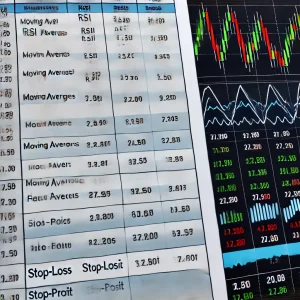فهرس المحتوي
ToggleEffective Forex Trading Plans A Deep Dive into Strategy Creation
Introduction
Creating a solid trading plan is crucial for success in the Forex market. It serves as a blueprint, guiding traders through various market conditions and helping them make informed decisions. This article explores the essential components of a trading plan, how to develop one, and why it’s a vital part of any trader’s toolkit.
1. Understanding the Basics of a Trading Plan
A trading plan outlines your strategy, risk management approach, and trading goals. It is tailored to individual trading styles and objectives. Developing a plan starts with defining your goals, setting realistic profit expectations, and determining your risk tolerance.
Key Elements of a Trading Plan:
- Trading Goals: Set specific, measurable, and time-bound goals.
- Risk Management: Determine risk per trade, position size, and maximum drawdown.
- Entry and Exit Rules: Clearly define when to enter and exit trades.
- Trading Schedule: Establish trading hours based on the most active sessions for the currency pairs you trade.

2. Setting Realistic Goals and Expectations
Many traders fail because they set unrealistic expectations. A good trading plan should have achievable goals, such as aiming for a 3% monthly return rather than expecting to double your capital within a short period. Break your goals into smaller milestones and review them regularly.
Pro Tip: Use tools like trading journals to track your progress and evaluate your strategy’s effectiveness over time.
3. Risk Management: The Backbone of a Trading Plan
Risk management is perhaps the most crucial element of any trading plan. Define how much you’re willing to risk per trade, typically 1-2% of your total capital. Set stop-loss and take-profit levels to protect your account from excessive losses and lock in profits.
Strategies for Effective Risk Management:
- Position Sizing: Calculate your position size based on your account balance and risk percentage.
- Diversification: Spread your trades across different currency pairs to reduce exposure.
- Drawdown Control: Implement a rule to pause trading if your drawdown exceeds a certain level.
4. Entry and Exit Strategies
Your trading plan should specify precise entry and exit points. Use technical indicators like moving averages, RSI, and Fibonacci retracement to identify these points.
Types of Entry and Exit Strategies:
- Breakout Trading: Enter trades when the price breaks through a support or resistance level.
- Trend Following: Trade in the direction of the trend using indicators like moving averages.
- Reversal Trading: Identify trend reversals using oscillators like RSI or MACD.
5. Incorporating Technical and Fundamental Analysis
A comprehensive trading plan combines both technical and fundamental analysis. Technical analysis helps pinpoint entry and exit points, while fundamental analysis provides a broader understanding of market trends based on economic indicators, news events, and geopolitical factors.
Example: When trading the EUR/USD pair, a trader might use fundamental analysis to evaluate the impact of ECB policy changes while using technical indicators to identify short-term trading opportunities.
6. Backtesting and Refining Your Plan
Before using a trading plan in live markets, it’s essential to backtest it on historical data. Platforms like MetaTrader 4/5 offer robust backtesting features that allow you to evaluate your strategy’s performance. Adjust your plan based on backtesting results and market observations.
Steps for Effective Backtesting:
- Choose a reliable platform with historical data.
- Apply your trading plan and record results.
- Analyze performance metrics such as win rate, risk-to-reward ratio, and maximum drawdown.
7. Maintaining Discipline and Consistency
Even the best trading plan is useless without discipline. Stick to your plan and avoid impulsive trades. Emotional trading often leads to significant losses. Use trading journals to document your trades and learn from your mistakes.

Discipline Tips:
- Avoid overtrading and revenge trading.
- Take regular breaks to prevent burnout.
- Set alerts to monitor potential trade setups without staring at the screen all day.
8. Regularly Reviewing and Updating Your Plan
The forex market is dynamic, and your trading plan should adapt to changing market conditions. Regularly review your plan, incorporate new strategies, and adjust risk parameters based on your trading performance.
How to Conduct Regular Reviews:
- Set a monthly review date to assess your plan’s effectiveness.
- Make data-driven decisions based on your trading journal.
- Be open to modifying your plan to suit new market conditions.
Conclusion
An effective trading plan is the cornerstone of successful forex trading. By setting realistic goals, managing risk, and maintaining discipline, traders can navigate the complexities of the forex market with confidence. Remember, your trading plan is not a static document—it should evolve with your trading journey.














